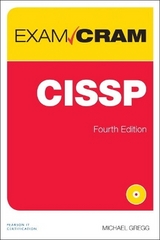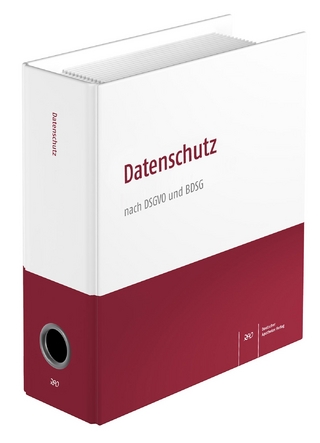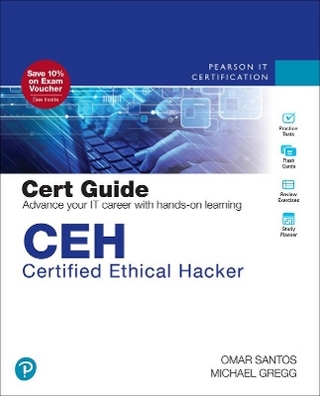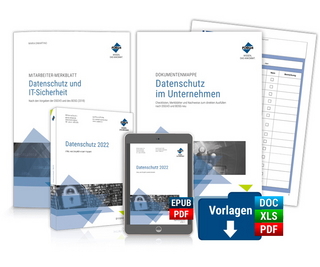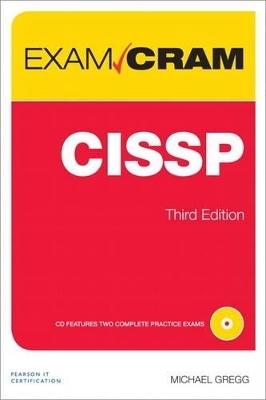
CISSP Exam Cram
Pearson IT Certification
978-0-7897-4957-4 (ISBN)
- Titel erscheint in neuer Auflage
- Artikel merken
Covers the critical information you’ll need to pass the CISSP exam!
Enforce effective physical security throughout your organization
Apply reliable authentication, authorization, and accountability
Design security architectures that can be verified, certified, and accredited
Understand the newest attacks and countermeasures
Use encryption to safeguard data, systems, and networks
Systematically plan and test business continuity/disaster recovery programs
Protect today’s cloud, web, and database applications
Address global compliance issues, from privacy to computer forensics
Develop software that is secure throughout its entire lifecycle
Implement effective security governance and risk management
Use best-practice policies, procedures, guidelines, and controls
Ensure strong operational controls, from background checks to security audits
The CD-ROM comes with two free complete practice exams and includes the Cram Sheet.
As the founder and president of Superior Solutions, Inc., a Houston-based IT security consulting and auditing firm, Michael Gregg has more than 20 years of experience in information security and risk management. He holds two associate’s degrees, a bachelor’s degree, and a master’s degree. Some of the certifications he holds include CISA, CISSP, MCSE, CTT+, A+, N+, Security+, CASP, CCNA, GSEC, CEH, CHFI, CEI, CISA, CISM, CGEIT, and SSCP. In addition to his experience with performing security audits and assessments, Gregg has authored or coauthored more than 15 books, including Certified Ethical Hacker Exam Prep (Que), CISSP Exam Cram 2 (Que), and Security Administrator Street Smarts (Sybex). He is a site expert for TechTarget.com websites, such as SearchNetworking.com. He also serves on their editorial advisory board. His articles have been published on IT websites and he has been quoted on Fox News and the in the New York Times. He has created more than 15 security-related courses and training classes for various companies and universities. Although audits and assessments are where he spends the bulk of his time, teaching and contributing to the written body of IT security knowledge are how Michael believes he can give something back to the community that has given him so much. He is a board member for Habitat for Humanity and when not working, Michael enjoys traveling and restoring muscle cars.
Introduction. . . . 1
How to Prepare for the Exam. . . 1
Practice Tests . . . 2
Taking a Certification Exam . . . 2
Arriving at the Exam Location . . 2
In the Testing Center . . . 3
After the Exam. . . 3
Retaking a Test . . . 3
Tracking Your CISSP Status . . 3
About This Book. . . 4
The Chapter Elements. . . 4
Other Book Elements. . . 7
Chapter Contents . . . 7
Pearson IT Certification Practice Test Engine and Questions on the CD . . . . 9
Install the Software from the CD. . 10
Activate and Download the Practice Exam . . 11
Activating Other Exams . . . 11
Contacting the Author . . . 12
Self-Assessment. . . 12
CISSPs in the Real World . . . 12
The Ideal CISSP Candidate . . 12
Put Yourself to the Test . . . 13
After the Exam . . . 15
Chapter 1: The CISSP Certification Exam . . . 17
Introduction. . . . 18
Assessing Exam Readiness . . . 18
Taking the Exam . . . 19
Multiple-Choice Question Format . . 21
Exam Strategy . . . 21
Question-Handling Strategies . . . 22
Mastering the Inner Game . . . 23
Need to Know More? . . . 24
Chapter 2: Physical Security . . . . 25
Introduction. . . . 26
Physical Security Risks. . . 26
Natural Disasters. . . 27
Man-Made Threats. . . 28
Technical Problems. . . 28
Facility Concerns and Requirements . . 29
CPTED . . . 30
Area Concerns . . . 30
Location . . . 31
Construction . . . 32
Doors, Walls, Windows, and Ceilings . . 32
Asset Placement. . . 35
Physical Port Controls . . . 36
Perimeter Controls. . . 36
Fences . . . . 36
Gates. . . . 38
Bollards. . . . 39
CCTV Cameras . . . 40
Lighting . . . 41
Guards and Dogs . . . 42
Locks. . . . 43
Employee Access Control . . . 46
Badges, Tokens, and Cards . . 47
Biometric Access Controls. . . 48
Environmental Controls . . . 49
Heating, Ventilating, and Air Conditioning . . 50
Electrical Power . . . 51
Uninterruptible Power Supply . . 52
Equipment Life Cycle . . . 53
Fire Prevention, Detection, and Suppression . . 53
Fire-Detection Equipment . . 54
Fire Suppression . . . 54
Alarm Systems . . . 57
Intrusion Detection Systems . . 57
Monitoring and Detection. . . 58
Exam Prep Questions. . . 60
Answers to Exam Prep Questions . . 62
Suggested Reading and Resources . . 64
Chapter 3: Access Control Systems and Methodology. . 65
Introduction. . . . 66
Identification, Authentication, and Authorization . . 67
Authentication . . . 67
Access Management . . . 79
Single Sign-On . . . 80
Kerberos. . . 81
SESAME . . . 83
Authorization and Access Controls Techniques . . 84
Discretionary Access Control . . 84
Mandatory Access Control . . 85
Role-Based Access Control . . 87
Other Types of Access Controls . . 88
Access Control Methods . . . 89
Centralized Access Control . . 89
Decentralized Access Control . . 92
Access Control Types . . . 93
Administrative Controls. . . 93
Technical Controls . . . 94
Physical Controls . . . 94
Access Control Categories. . . 95
Audit and Monitoring . . . 96
Monitoring Access and Usage. . 96
Intrusion Detection Systems . . 97
Intrusion Prevention Systems . . 101
Network Access Control . . . 102
Keystroke Monitoring . . . 102
Emanation Security . . . 103
Access Control Attacks. . . 104
Unauthorized Access . . . 104
Access Aggregation . . . 105
Password Attacks. . . 105
Spoofing . . . 109
Sniffing . . . 109
Eavesdropping and Shoulder Surfing. . 110
Wiretapping. . . 110
Identity Theft . . . 110
Denial of Service Attacks . . . 111
Distributed Denial of Service Attacks . . 113
Botnets . . . 113
Exam Prep Questions. . . 116
Answers to Exam Prep Questions . . 119
Suggesting Reading and Resources . . 121
Chapter 4: Cryptography. . . . 123
Introduction. . . . 124
Cryptographic Basics . . . 124
History of Encryption . . . 127
Steganography. . . 132
Steganography Operation . . 133
Digital Watermark . . . 134
Algorithms . . . . 135
Cipher Types and Methods . . . 137
Symmetric Encryption . . . 137
Data Encryption Standard. . 140
Triple-DES . . . 144
Advanced Encryption Standard. . 145
International Data Encryption Algorithm. . 146
Rivest Cipher Algorithms . . 146
Asymmetric Encryption . . . 147
Diffie-Hellman . . . 149
RSA. . . . 150
El Gamal . . . 151
Elliptical Curve Cryptosystem . . 152
Merkle-Hellman Knapsack . . 152
Review of Symmetric and Asymmetric Cryptographic Systems . . . 153
Hybrid Encryption . . . 153
Integrity and Authentication. . . 154
Hashing and Message Digests. . 155
Digital Signatures . . . 158
Cryptographic System Review . . 159
Public Key Infrastructure . . . 160
Certificate Authority . . . 160
Registration Authority . . . 161
Certificate Revocation List . . 161
Digital Certificates . . . 161
The Client’s Role in PKI . . . 163
Email Protection Mechanisms . . . 164
Pretty Good Privacy. . . 164
Other Email Security Applications. . 165
Securing TCP/IP with Cryptographic Solutions. . 165
Application/Process Layer Controls . . 166
Host to Host Layer Controls . . 167
Internet Layer Controls. . . 168
Network Access Layer Controls . . 170
Link and End-to-End Encryption . . 170
Cryptographic Attacks . . . 171
Exam Prep Questions. . . 175
Answers to Exam Prep Questions . . 178
Need to Know More? . . . 180
Chapter 5: Security Architecture and Models . . . 181
Introduction. . . . 182
Computer System Architecture . . 182
Central Processing Unit . . . 182
Storage Media . . . 186
I/O Bus Standards. . . 189
Hardware Cryptographic Components . . 190
Virtual Memory and Virtual Machines . . 190
Computer Configurations . . 191
Security Architecture . . . 192
Protection Rings . . . 192
Trusted Computer Base . . . 194
Open and Closed Systems . . 197
Security Modes of Operation . . 197
Operating States . . . 199
Recovery Procedures . . . 199
Process Isolation . . . 200
Security Models . . . 201
State Machine Model . . . 202
Information Flow Model . . . 203
Noninterference Model . . . 203
Confidentiality. . . 203
Integrity . . . 204
Other Models . . . 208
Documents and Guidelines . . . 208
The Rainbow Series . . . 209
The Red Book: Trusted Network Interpretation . 211
Information Technology Security Evaluation Criteria . 212
Common Criteria . . . 212
System Validation . . . 214
Certification and Accreditation. . 215
Governance and Enterprise Architecture . . 216
Security Architecture Threats. . . 219
Buffer Overflow . . . 219
Back Doors . . . 220
Asynchronous Attacks . . . 220
Covert Channels . . . 221
Incremental Attacks . . . 221
Exam Prep Questions. . . 223
Answers to Exam Prep Questions . . 226
Need to Know More? . . . 228
Chapter 6: Telecommunications and Network Security . . 229
Introduction. . . . 230
Network Models and Standards . . 230
OSI Model . . . 231
Encapsulation/De-Encapsulation . . 237
TCP/IP . . . . 238
Network Access Layer . . . 238
Internet Layer . . . 239
Host-to-Host (Transport) Layer. . 243
Application Layer . . . 245
LANs and Their Components . . . 249
LAN Communication Protocols . . 250
Network Topologies . . . 251
LAN Cabling. . . 253
Network Types . . . 255
Communication Standards . . . 256
Network Equipment. . . 257
Repeaters . . . 257
Hubs . . . . 257
Bridges . . . 257
Switches . . . 258
VLANs . . . 259
Routers . . . 260
Brouters . . . 261
Gateways . . . 261
Routing. . . . 262
WANs and Their Components . . 264
Packet Switching. . . 264
Circuit Switching . . . 266
Cloud Computing. . . 270
Voice Communications and Wireless Communications . 271
Voice over IP . . . 271
Cell Phones . . . 272
802.11 Wireless Networks and Standards . . 274
Network Security . . . 281
Firewalls . . . 282
Demilitarized Zone. . . 283
Firewall Design . . . 285
Remote Access. . . 285
Point-to-Point Protocol. . . 286
Virtual Private Networks . . . 287
Remote Authentication Dial-in User Service . 288
Terminal Access Controller Access Control System . 288
IPSec. . . . 288
Message Privacy . . . 289
Threats to Network Security . . . 290
DoS Attacks . . . 290
Distributed Denial of Service . . 291
Disclosure Attacks. . . 291
Destruction, Alteration, or Theft . . 292
Exam Prep Questions. . . 295
Answers to Exam Prep Questions . . 298
Need to Know More? . . . 299
Chapter 7: Business Continuity and Disaster Recovery Planning. . 301
Introduction. . . . 302
Threats to Business Operations . . 302
Disaster Recovery and Business Continuity Management . 303
Project Management and Initiation . . 305
Business Impact Analysis . . . 307
Recovery Strategy . . . 313
Plan Design and Development . . 327
Implementation. . . 330
Testing . . . 331
Monitoring and Maintenance . . 333
Disaster Life Cycle . . . 334
Teams and Responsibilities . . 336
Exam Prep Questions. . . 338
Answers to Exam Prep Questions . . 341
Need to Know More? . . . 343
Chapter 8: Legal, Regulations, Investigations, and Compliance . . 345
Introduction. . . . 346
United States Legal System and Laws. . 346
International Legal Systems and Laws . . 347
International Property Laws . . . 349
Piracy and Issues with Copyrights . . 350
Privacy Laws and Protection of Personal Information . 351
Privacy Impact Assessment . . 353
Computer Crime Laws . . . 354
Regulatory Compliance and Process Control. . 354
Ethics . . . . 355
ISC2 Code of Ethics. . . 356
Computer Ethics Institute . . 357
Internet Architecture Board . . 357
NIST 800-14. . . 358
Computer Crime and Criminals. . 359
Pornography . . . 361
Well-Known Computer Crimes . . 362
How Computer Crime Has Changed . . 363
Attack Vectors . . . 364
Keystroke Logging . . . 365
Wiretapping. . . 365
Spoofing Attacks . . . 366
Manipulation Attacks . . . 367
Social Engineering . . . 367
Dumpster Diving . . . 368
Investigating Computer Crime. . . 368
Computer Crime Jurisdiction . . 369
Incident Response. . . 369
Forensics . . . . 374
Standardization of Forensic Procedures . . 375
Computer Forensics . . . 376
Investigations. . . 381
Search, Seizure, and Surveillance . . 381
Interviews and Interrogations . . 381
Honeypots and Honeynets . . 381
Evidence Types . . . 383
Trial . . . . 384
The Evidence Life Cycle . . . 384
Exam Prep Questions. . . 385
Answers to Exam Prep Questions . . 388
Need to Know More? . . . 390
Chapter 9: Software Development Security . . . 391
Introduction. . . . 392
Software Development. . . 392
Avoiding System Failure . . . 393
The System Development Life Cycle . . 394
System Development Methods. . . 402
The Waterfall Model . . . 402
The Spiral Model . . . 402
Joint Application Development . . 403
Rapid Application Development. . 404
Incremental Development . . 404
Prototyping . . . 404
Computer-Aided Software Engineering . . 405
Agile Development Methods. . 405
Capability Maturity Model . . 406
Scheduling . . . 407
Change Management . . . 408
Programming Languages. . . 409
Object-Oriented Programming . . 412
CORBA . . . 413
Database Management. . . 413
Database Terms. . . 414
Integrity . . . 416
Transaction Processing. . . 416
Data Warehousing . . . 416
Data Mining . . . 417
Knowledge Management . . . 418
Artificial Intelligence and Expert Systems. . 418
Malicious Code . . . 419
Viruses . . . 420
Worms . . . 421
Spyware . . . 422
Back Doors and Trapdoors . . 423
Change Detection. . . 423
Mobile Code . . . 424
Financial Attacks . . . 424
Buffer Overflow . . . 424
Input Validation and Injection Attacks . . 426
Exam Prep Questions. . . 429
Answers to Exam Prep Questions . . 432
Need to Know More? . . . 434
Chapter 10: Information Security Governance and Risk Management . . 435
Introduction. . . . 436
Basic Security Principles . . . 436
Security Management and Governance. . 438
Asset Identification . . . 440
Risk Assessment . . . 441
Risk Management . . . 442
Policies Development. . . 458
Security Policy. . . 459
Standards . . . 461
Baselines . . . 461
Guidelines . . . 461
Procedures . . . 462
Data Classification . . . 462
Implementation. . . 465
Roles and Responsibility . . . 465
Security Controls . . . 467
Training and Education . . . 469
Security Awareness . . . 470
Social Engineering . . . 471
Auditing Your Security Infrastructure . . 472
The Risk of Poor Security Management. . 474
Exam Prep Questions. . . 475
Answers to Exam Prep Questions . . 478
Need to Know More? . . . 480
Chapter 11: Security Operations . . . 481
Introduction. . . . 482
Security Operations . . . 482
Employee Recruitment . . . 483
New-Hire Orientation . . . 484
Separation of Duties. . . 484
Job Rotation. . . 485
Least Privilege. . . 485
Mandatory Vacations . . . 486
Termination . . . 486
Accountability . . . 486
Controls . . . . 488
Security Controls . . . 489
Operational Controls . . . 490
Auditing and Monitoring. . . 498
Auditing . . . 498
Security Information and Event Management (SIEM) . 499
Monitoring Controls . . . 499
Clipping Levels . . . 501
Intrusion Detection . . . 501
Keystroke Monitoring . . . 502
Antivirus . . . 503
Facility Access Control . . . 504
Telecommunication Controls . . . 504
Fax. . . . 505
PBX. . . . 506
Email. . . . 507
Backup, Fault Tolerance, and Recovery Controls . . 509
Backups. . . 509
Fault Tolerance . . . 511
RAID . . . . 513
Recovery Controls . . . 515
Security Assessments . . . 516
Policy Reviews. . . 516
Vulnerability Scanning . . . 517
Penetration Testing. . . 518
Operational Security Threats and Vulnerabilities . . 521
Common Attack Methodologies. . 522
Attack Terms and Techniques . . 524
Exam Prep Questions. . . 526
Answers to Exam Prep Questions . . 529
Need to Know More? . . . 531
Practice Exam I. . . . 533
Practice Exam Questions. . . 533
Answers to Practice Exam I . . . 547
Practice Exam II . . . . 563
Practice Exam Questions. . . 563
Answers to Practice Exam II . . . 577
TOC, 9780789749574, 11/2/2012
| Erscheint lt. Verlag | 10.12.2012 |
|---|---|
| Verlagsort | Upper Saddle River |
| Sprache | englisch |
| Maße | 157 x 227 mm |
| Gewicht | 840 g |
| Themenwelt | Informatik ► Netzwerke ► Sicherheit / Firewall |
| Informatik ► Weitere Themen ► Zertifizierung | |
| ISBN-10 | 0-7897-4957-2 / 0789749572 |
| ISBN-13 | 978-0-7897-4957-4 / 9780789749574 |
| Zustand | Neuware |
| Haben Sie eine Frage zum Produkt? |
aus dem Bereich
